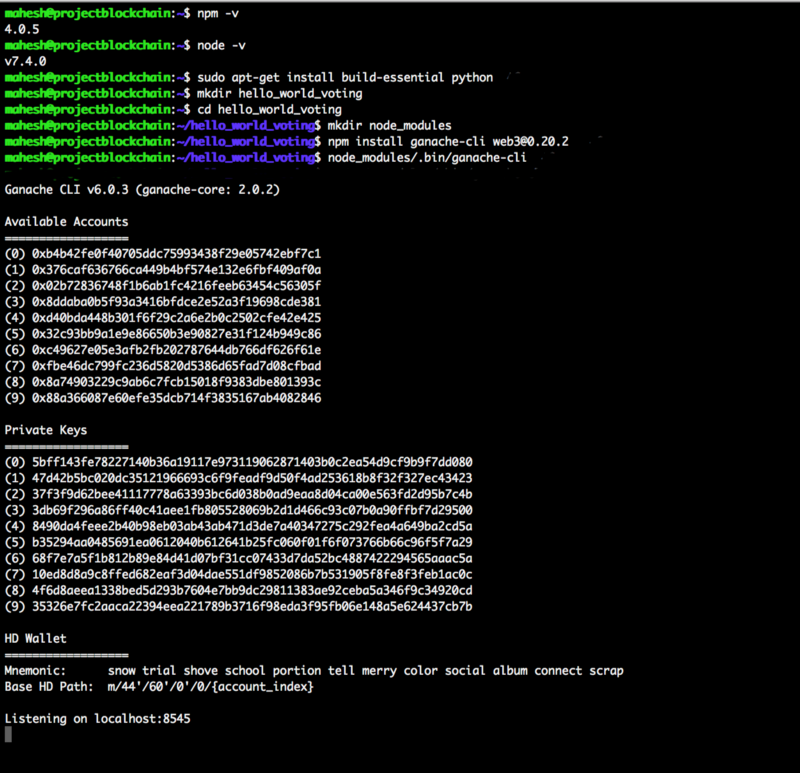жӮЁеҘҪпјҢзҷ»еҪ•еҗҺжүҚиғҪдёӢи®ўеҚ•е“ҰпјҒ
жң¬зҜҮеҶ…е®№дё»иҰҒи®Іи§ЈвҖңд»ҘеӨӘеқҠжҷәиғҪеҗҲзәҰејҖеҸ‘DAppзҡ„ж–№жі•жҳҜд»Җд№ҲвҖқпјҢж„ҹе…ҙи¶Јзҡ„жңӢеҸӢдёҚеҰЁжқҘзңӢзңӢгҖӮжң¬ж–Үд»Ӣз»Қзҡ„ж–№жі•ж“ҚдҪңз®ҖеҚ•еҝ«жҚ·пјҢе®һз”ЁжҖ§ејәгҖӮдёӢйқўе°ұи®©е°Ҹзј–жқҘеёҰеӨ§е®¶еӯҰд№ вҖңд»ҘеӨӘеқҠжҷәиғҪеҗҲзәҰејҖеҸ‘DAppзҡ„ж–№жі•жҳҜд»Җд№ҲвҖқеҗ§!
жҲ‘们дҪҝз”ЁдёҖдёӘжЁЎжӢҹзҡ„еҶ…еӯҳеҢәеқ—й“ҫ(ganache)д»Јжӣҝзңҹе®һзҡ„еҢәеқ—й“ҫеңЁиҝӣиЎҢејҖеҸ‘гҖӮеңЁжң¬ж•ҷзЁӢзҡ„2з« пјҢжҲ‘们е°ҶдёҺзңҹе®һзҡ„еҢәеқ—й“ҫдәӨдә’гҖӮдёӢйқўжҳҜе®үиЈ…ganacheгҖҒweb3jsзҡ„жӯҘйӘӨпјҢ然еҗҺеңЁlinuxдёҠеҗҜеҠЁдёҖдёӘжөӢиҜ•й“ҫгҖӮеңЁmacOSдёҠе®үиЈ…иҝҮзЁӢд№ҹжҳҜдёҖж ·зҡ„гҖӮ

дҪ еҸҜд»ҘзңӢеҲ°ganache-cliиҮӘеҠЁеҲӣе»әдәҶ10дёӘжөӢиҜ•иҙҰеҸ·,жҜҸдёӘиҙҰеҸ·йў„еҲҶй…ҚдәҶ100(иҷҡжһ„зҡ„)ethers
еҰӮжһңйңҖиҰҒжӣҙиҜҰз»Ҷзҡ„ејҖеҸ‘зҺҜеўғе®үиЈ…ж•ҷзЁӢпјҢеҸҜд»ҘеҸӮиҖғеҰӮдёӢж–Үз« пјҡ
windowsд»ҘеӨӘеқҠејҖеҸ‘зҺҜеўғжҗӯе»ә
linux/ubuntuд»ҘеӨӘеқҠејҖеҸ‘зҺҜеўғжҗӯе»ә
жҲ‘们е°ҶдҪҝз”Ёsolidityзј–зЁӢиҜӯиЁҖжқҘзј–еҶҷжҲ‘们зҡ„еҗҲзәҰгҖӮеҰӮжһңжӮЁзҶҹжӮүйқўеҗ‘еҜ№иұЎзј–зЁӢпјҢеӯҰд№ зј–еҶҷsolidityеҗҲзәҰеә”иҜҘжҳҜиҪ»иҖҢжҳ“дёҫзҡ„дәӢгҖӮжҲ‘们е°Ҷзј–еҶҷдёҖдёӘеҗҲзәҰеҜ№иұЎпјҢеҗ«жңүдёҖдёӘжһ„йҖ еҮҪж•°еҲқе§ӢеҢ–еҖҷйҖүдәәж•°з»„гҖӮеҗҲзәҰеҜ№иұЎжңү2дёӘж–№жі•пјҡ
иҝ”еӣһеҖҷйҖүдәәиҺ·еҫ—зҡ„жҖ»зҘЁж•°
еўһеҠ еҖҷйҖүдәәзҡ„жҠ•зҘЁж•°гҖӮ
жіЁж„Ҹпјҡжһ„йҖ еҮҪж•°еҸӘиў«и°ғз”ЁдёҖж¬ЎпјҢеҪ“жӮЁйғЁзҪІеҗҲзәҰеҲ°еҢәеқ—й“ҫгҖӮдёҚеғҸеңЁзҪ‘з»ңдё–з•ҢйҮҢзҡ„жҜҸдёҖдёӘйғЁзҪІдҪ зҡ„д»Јз ҒиҰҶзӣ–ж—§зҡ„д»Јз ҒпјҢйғЁзҪІеҗҺзҡ„д»Јз ҒеңЁеҢәеқ—й“ҫдёҠжҳҜдёҚеҸҳзҡ„гҖӮдҫӢеҰӮпјҢеҰӮжһңдҪ жӣҙж–°дҪ зҡ„еҗҲзәҰ并且еҶҚж¬ЎйғЁзҪІпјҢж—§еҗҲзәҰд»Қ然дјҡеңЁеҢәеқ—й“ҫдёҠ, е®ғжүҖеӯҳеӮЁзҡ„ж•°жҚ®дёҚеҸ—еҪұе“ҚпјҢж–°зҡ„йғЁзҪІе°ҶеҲӣе»әдёҖдёӘж–°е®һдҫӢзҡ„еҗҲзәҰгҖӮ
дёӢйқўжҳҜжҠ•зҘЁеҗҲзәҰзҡ„д»Јз Ғ:
pragma solidity ^0.4.18; // We have to specify what version of compiler this code will compile with
contract Voting {
/* mapping field below is equivalent to an associative array or hash. The key of the mapping is candidate name stored as type bytes32 and value is an unsigned integer to store the vote count */
mapping (bytes32 => uint8) public votesReceived;
/* Solidity doesn't let you pass in an array of strings in the constructor (yet). We will use an array of bytes32 instead to store the list of candidates */
bytes32[] public candidateList;
/* This is the constructor which will be called once when you deploy the contract to the blockchain. When we deploy the contract, we will pass an array of candidates who will be contesting in the election */
function Voting(bytes32[] candidateNames) public {
candidateList = candidateNames;
}
// This function returns the total votes a candidate has received so far function totalVotesFor(bytes32 candidate) view public returns (uint8) { require(validCandidate(candidate)); return votesReceived[candidate];
}
// This function increments the vote count for the specified candidate. This // is equivalent to casting a vote function voteForCandidate(bytes32 candidate) public { require(validCandidate(candidate));
votesReceived[candidate] += 1;
}
function validCandidate(bytes32 candidate) view public returns (bool) { for(uint i = 0; i < candidateList.length; i++) {
if (candidateList[i] == candidate) { return true;
}
} return false;
}
}еӨҚеҲ¶дёҠйқўзҡ„д»Јз ҒпјҢеңЁhello_world_votingзӣ®еҪ•дёӢеҲӣе»әдёҖдёӘVoting.solж–Ү件гҖӮзҺ°еңЁи®©жҲ‘们жқҘзј–иҜ‘д»Јз Ғ并е°Ҷе…¶йғЁзҪІеҲ°ganacheзҡ„еҢәеқ—й“ҫдёҠ.
дёәдәҶзј–иҜ‘solidityд»Јз ҒпјҢжҲ‘们йңҖиҰҒе®үиЈ…еҗҚеӯ—дёәsolcзҡ„npmжЁЎеқ—
~/hello_world_voting$ npm install solc
жҲ‘们е°ҶеңЁnodeжҺ§еҲ¶еҸ°дёӯдҪҝз”ЁиҝҷдёӘеә“жқҘзј–иҜ‘жҲ‘们зҡ„еҗҲзәҰгҖӮеңЁдёҠдёҖзҜҮж–Үз« дёӯжҲ‘们жҸҗеҲ°пјҢweb3jsжҳҜдёҖдёӘи®©жҲ‘们еҸҜд»ҘйҖҡиҝҮrpcи®ҝй—®еҢәеқ—й“ҫзҡ„еә“гҖӮжҲ‘们е°ҶдҪҝз”ЁиҜҘеә“жқҘйғЁзҪІжҲ‘们зҡ„еә”з”ЁзЁӢеәҸ并дёҺд№ӢдәӨдә’гҖӮ
йҰ–е…ҲпјҢеңЁе‘Ҫд»ӨиЎҢдёӯж–ӯиҝҗиЎҢnodeе‘Ҫд»Өиҝӣе…ҘnodeжҺ§еҲ¶еҸ°пјҢеҲқе§ӢеҢ–solcе’Ңж–Үжң¬еҜ№иұЎгҖӮдёӢйқўзҡ„жүҖжңүд»Јз ҒзүҮж®өйғҪйңҖиҰҒеңЁnodeжҺ§еҲ¶еҸ°дёӯй”®е…Ҙ
~/hello_world_voting$ node
> Web3 = require('web3')
> web3 = new Web3(new Web3.providers.HttpProvider("http://localhost:8545"));дёәдәҶзЎ®дҝқweb3еҜ№иұЎе·Із»ҸеҲқе§ӢеҢ–гҖҒеҢәеқ—й“ҫиғҪеӨҹи®ҝй—®пјҢи®©жҲ‘们иҜ•дёҖдёӢжҹҘиҜўеҢәеқ—й“ҫдёҠзҡ„жүҖжңүиҙҰжҲ·гҖӮжӮЁеә”иҜҘзңӢеҲ°еҰӮдёӢзҡ„з»“жһңпјҡ
> web3.eth.accounts ['0x9c02f5c68e02390a3ab81f63341edc1ba5dbb39e', '0x7d920be073e92a590dc47e4ccea2f28db3f218cc', '0xf8a9c7c65c4d1c0c21b06c06ee5da80bd8f074a9', '0x9d8ee8c3d4f8b1e08803da274bdaff80c2204fc6', '0x26bb5d139aa7bdb1380af0e1e8f98147ef4c406a', '0x622e557aad13c36459fac83240f25ae91882127c', '0xbf8b1630d5640e272f33653e83092ce33d302fd2', '0xe37a3157cb3081ea7a96ba9f9e942c72cf7ad87b', '0x175dae81345f36775db285d368f0b1d49f61b2f8', '0xc26bda5f3370bdd46e7c84bdb909aead4d8f35f3']
д»Һvoting.solеҠ иҪҪд»Јз ҒпјҢдҝқеӯҳеңЁдёҖдёӘеӯ—з¬ҰдёІеҸҳйҮҸдёӯпјҢ然еҗҺејҖе§Ӣзј–иҜ‘
> code = fs.readFileSync('Voting.sol').toString()
> solc = require('solc')
> compiledCode = solc.compile(code)еҪ“дҪ зҡ„д»Јз Ғзј–иҜ‘жҲҗеҠҹ并жү“еҚ°дәҶеҗҲзәҰеҜ№иұЎзҡ„еҶ…е®№(еңЁnodeжҺ§еҲ¶еҸ°дёӯиҫ“еҮәзҡ„еҶ…е®№)пјҢжңү2дёӘеӯ—ж®өеҫҲйҮҚиҰҒпјҢйңҖиҰҒзҗҶи§Је®ғ们пјҡ
compiledCode.contracts[вҖҳ:VotingвҖҷ].bytecodeпјҡ Voting.solжәҗд»Јз Ғзј–иҜ‘еҗҺеҫ—еҲ°зҡ„еӯ—иҠӮз ҒгҖӮиҝҷжҳҜе°Ҷиў«йғЁзҪІеҲ°blockchainзҡ„д»Јз ҒгҖӮ
compiledCode.contracts[вҖҳ:VotingвҖҷ].interfaceпјҡ еҗҲзәҰжҺҘеҸЈжҲ–жЁЎжқҝпјҲз§°дёәABIпјүе‘ҠиҜүз”ЁжҲ·еҗҲзәҰеҗ«жңүе“Әдәӣж–№жі•гҖӮжӮЁйңҖиҰҒиҝҷдәӣABIзҡ„е®ҡд№үпјҢеӣ дёәе°ҶжқҘдҪ жҖ»жҳҜйңҖиҰҒдёҺеҗҲзәҰдәӨдә’зҡ„гҖӮ
еҲ°жӯӨпјҢзӣёдҝЎеӨ§е®¶еҜ№вҖңд»ҘеӨӘеқҠжҷәиғҪеҗҲзәҰејҖеҸ‘DAppзҡ„ж–№жі•жҳҜд»Җд№ҲвҖқжңүдәҶжӣҙж·ұзҡ„дәҶи§ЈпјҢдёҚеҰЁжқҘе®һйҷ…ж“ҚдҪңдёҖз•Әеҗ§пјҒиҝҷйҮҢжҳҜдәҝйҖҹдә‘зҪ‘з«ҷпјҢжӣҙеӨҡзӣёе…іеҶ…е®№еҸҜд»Ҙиҝӣе…Ҙзӣёе…ійў‘йҒ“иҝӣиЎҢжҹҘиҜўпјҢе…іжіЁжҲ‘们пјҢ继з»ӯеӯҰд№ пјҒ
е…ҚиҙЈеЈ°жҳҺпјҡжң¬з«ҷеҸ‘еёғзҡ„еҶ…е®№пјҲеӣҫзүҮгҖҒи§Ҷйў‘е’Ңж–Үеӯ—пјүд»ҘеҺҹеҲӣгҖҒиҪ¬иҪҪе’ҢеҲҶдә«дёәдё»пјҢж–Үз« и§ӮзӮ№дёҚд»ЈиЎЁжң¬зҪ‘з«ҷз«ӢеңәпјҢеҰӮжһңж¶үеҸҠдҫөжқғиҜ·иҒ”зі»з«ҷй•ҝйӮ®з®ұпјҡis@yisu.comиҝӣиЎҢдёҫжҠҘпјҢ并жҸҗдҫӣзӣёе…іиҜҒжҚ®пјҢдёҖз»ҸжҹҘе®һпјҢе°Ҷз«ӢеҲ»еҲ йҷӨж¶үе«ҢдҫөжқғеҶ…е®№гҖӮ
жӮЁеҘҪпјҢзҷ»еҪ•еҗҺжүҚиғҪдёӢи®ўеҚ•е“ҰпјҒ